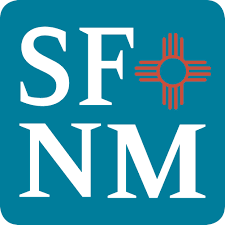Innovation Village aims to combine tech and housing

Planned development on south side would bring live-work-play opportunities
Santa Fe New Mexican
March 30, 2021
By Teya Vitu [email protected]
John F. Rizzo wants to put the technology sector front and center in Santa Fe.
He owns 140 acres of south-side real estate he is positioning to create something he calls the Santa Fe Innovation Village — with tech companies, residences, entertainment and dining to create a live-work-play dynamic at the south edge of the expansive Las Soleras development.
Rizzo, a Silicon Valley entrepreneur who was among the bidders for the midtown campus, has turned his attention south and west in the year since his proposal was bypassed by the city. He says his vision for the innovation village is still fluid — no count yet of how much housing or office space he wants to build — but he expects to be ready to ask for zoning changes and approval for a planned unit development by the end of June.
Rizzo also awaits city approvals to apply Midtown LINC (Local Innovation Corridor overlay district) components to his project, such as a streamlined development process, more modernized architecture and increased density that would allow for a 75-foot height limit. He hopes to start building something next year, likely housing.
Rizzo, once a part-time Santa Fe resident who relocated here a year ago, is passionate about diversifying the city’s economy into high-tech beyond the bustling film sector that has embraced Santa Fe and Albuquerque.
“The film industry has shown that New Mexico can be a leading place for film production,” Rizzo said. “[Santa Fe Innovation Village] can be a little supercharger into the economy that will be helpful for everybody.”
The Santa Fe tech sector has been slowly growing since the establishment of the Santa Fe Business Incubator in 1998.
“These companies are not highly visible,” said Marie Longserre, the incubator’s CEO. “There is more than we think. I do believe there is a lot more tech here than people realize.”
With the ballyhooed midtown project in limbo for the moment, Rizzo is charging ahead with big plans for the city’s quickly expanding south side.
Rizzo wants to build his project between Beckner Road and Interstate 25 from just east of Richards Avenue to the Presbyterian Santa Fe Medical Center. It is part of his greater vision to create a New Mexico Innovation Triangle with more innovation villages in Los Alamos and Albuquerque.
Rizzo said he doesn’t intend to throw his hat back into that ring now that KDC Real Estate Development/Cienda Partners has stepped away as the master developer of the midtown campus.
“We’re pretty tied up on the south side,” Rizzo said. “We’re not asking for anything. It’s a privately financed project.”
The city’s economic development director, Rich Brown, said he sees Rizzo’s project adding to the patchwork of innovation centers sprouting around the city. Rizzo’s project, he added, would fit nicely in an innovation hub with Los Alamos and Albuquerque.
“We think of the three cities as part of an innovation triangle just like you have in North Carolina,” Brown said. “It’s innovation place-making of the future. It’s building a corridor in Santa Fe that helps us recruit companies and create jobs.”
Rizzo, 63, has been active in the Silicon Valley tech scene since being part of the Apple Macintosh development in the early 1980s. He also worked at Oracle and Intel before launching seven startups, selling his last, Deem in San Francisco, in 2019. He remained CEO until 2020.
Rizzo bought a house in Santa Fe 2½ years ago with plans to eventually retire here. The coronavirus sped up full-time residency here to March 2020.
“Why don’t we build a tech economy so I have something to do?” Rizzo said. “Could we build an innovation economy in Santa Fe?”
Over the past year, he pitched the notion to dozens of local and state leaders at Sunday brunches at his home.
New Mexico Innovation Triangle “was formed as a result of these meetings,” Rizzo said. “We want to create 25,000 jobs in 10 years in Northern New Mexico.”
His vision has caught the attention of others: Meow Wolf co-founder and former CEO Vince Kadlubek values the local jobs and substantial housing Rizzo wants to create on undeveloped land.
“The jobs which can be created are jobs New Mexicans get hired for in a state they grow up in and are educated in,” Kadlubek said. “We lose so much local talent. They just never had jobs or opportunities here.”
Kadlubek notes Rizzo’s proposed housing is near freeway access and Cerrillos Road.
“We have a lot of people at Meow Wolf that have a good job and live in Rio Rancho and Albuquerque,” he said. “I think dense and urban style living with amenities within walking distance is within the thinking of affordable housing.”
Rizzo and Joseph Karnes, counsel for New Mexico Innovation Triangle, are committing to building affordable housing rather than paying the city’s fee in lieu of providing affordable housing. Karnes said the project will meet the city requirement of providing 15 percent of affordable housing, with Rizzo adding: “It will meet but not exceed that.”
“We want teachers and baristas and students and police officers and coders and software developers living right there,” Rizzo said.
Drew Tulchin, president of the New Mexico Angels group of in-state investors, believes Rizzo’s project is an ideal way to add housing and jobs.
“More houses create more houses,” Tulchin said. “A thousand houses helps our city … Santa Fe is already unaffordable. For this to be a government/ tourist/retirement community is not a complete plan. … Let’s get the boomerangers, New Mexicans who left the state. Let’s give them a reason to come back.”
Rizzo has partnered with heavy hitters for his innovation triangle with the San Francisco-based global architecture firm Gensler and the Chicago-based global real estate and investment management firm JLL.
Gensler has designed high-profile projects around the world, among them Facebook’s corporate headquarters and the new Washington Post office, as well as the Hotel Chaco in Albuquerque.
“A lot of their work is post-COVID architecture with large tech companies,” Rizzo said. “What they are envisioning could be hybrid work in office, work at home. There could be walls pivoting into the ceiling. You can walk into an outdoor space.”
Rizzo envisions an area with offices that have collaborative space, individual work areas, videoconference space and residential design tailored to working at home. Rizzo recalls the average round-trip drive from his San Francisco company Deem for his 80 employees was 2.4 hours.
“Companies will tell us what they need in the concept of live-work-play,” he said. “Employers need to say to [job] candidates ‘This is where you are going to work. Isn’t it awesome?’ You can work here and you can walk to work in 10 minutes [or drive from anywhere in Santa Fe in less than 20 minutes].”
JLL buys, builds, occupies and invests in industrial, commercial, retail, residential and hotel real estate.
“They are raising the capital,” Rizzo said. “It’s going to be hundreds of millions of dollars over 10 years.”
All the serious planning for Santa Fe Innovation Village has come since the onset of the pandemic, with design aspects specifically incorporating the thinking of how the work world will emerge when the crisis ends.
“This will be the world’s first postCOVID innovation village,” Rizzo said. “There is this massive trend that people can live anywhere. There is job migration away from urban areas. Those people can be job creators here.”

